It’s very rare that DJ gear stands the test of time. This is partly due to the fickle nature of the user, but also in large part due to the perceived need by manufacturers to constantly update and refine their products to keep customers buying. One obvious candidate for survival would be the Technics 12xx series, which quite possibly ended up a victim of its own success. It’s rare that a mixer can boast an appearance on this list, but Allen & Heath’s Xone:92 can proudly claim that not only is it well into its second decade of constant production, it’s still an undisputed flagship in the industry.
Over the years, a lot of people have been hoping for a proper update to the mixer, something to bring it into the modern era (not me! — Dan), a 92 MKII. And here it is: the Xone:96, sporting two USB audio interfaces, a revised control surface, and… the call back to the original light-grey faceplate.
Allen & Heath Launches Xone:96
The wait is finally over. Allen & Heath (DJ) has responded to the demands of its customers, by following up a genuine club classic with their new flagship analogue DJ Mixer — Xone:96.
Aimed squarely at the artists who push the frontiers of music production and performance, Xone:96 takes the analogue soul of the universally acclaimed Xone:92 and re-delivers it, enhanced and with state-of-the-art digital connectivity.
Senior Product Manager, Allen & Heath’s David Morbey is justifiably excited:
“Xone:96 has it all. The huge, detailed, space-shaking Xone analogue sound. A refined, precision 4-band EQ with Xone:VCF filters and CRUNCH harmonic distortion. Plus a dual 32-bit USB soundcard (24 channels @ 96kHz) with Traktor Scratch certification straight out of the box.”
With a familiar layout of beautifully tactile controls and ground-breaking audio tools that allow the development of an individual’s signature sound, Xone:96 allows the user to easily connect their entire rig, from laptops and turntables, to pedals, synths and drum machines. There are two dedicated FX sends, four stereo input channels with 4-band EQ, two stereo inputs with all-new 3-band parametric EQ, two auxiliary stereo return channels and a separate master insert for outboard FX hardware.
Underlining the professional club credentials of Xone:96 is a new, second and completely independent headphone cueing system, which taken alongside the dual soundcard, allows for smoother set transitions and back-to-back performances. Dedicated booth outputs using a new 3-band booth EQ facilitate the tuning of a venue’s monitor rig and artists using complex, hybrid, multi-channel software will celebrate the simplicity of using a single USB to connect their computer to Xone:96.
As expected, Xone:96 features industrial build quality, which can be relied upon to comfortably withstand the demands of packed schedules, night after night.
David Morbey concludes:
“The launch of Xone:96 marks a highly significant moment for us, stemming as it does from our determination to take account of and act on feedback from the DJ community. The status of Xone:92 as an undisputed classic was something we took very seriously when developing Xone:96. It was clear that we couldn’t afford to lose its essence but also that we should seek to exceed the expectations of those who were pushing us to deliver another cutting-edge mixer. It isn’t overstating the case to say every fader, knob, button and switch has been subject to a forensic level of attention. Xone:96 is the answer to every question we were asked.”
Key features:
- Legendary Xone analogue design
- 6+2 channel layout
- Dual 24- channel 32Bit/96kHz soundcards
- Traktor Scratch Certified
- Dual Xone VCF filters with Crunch distortion
- Xone 4-Band EQ
- Two independent CUE systems
- innoFADER Cross Fader
Some specifications for those that love the numbers:
Xone 96 Specifications
Mix 1 output – Electronically balanced XLR 0VU = +4dBu, Insert level -2dBu
Maximum output level Mix 1 outputs +24dBu
Mix 2/Booth outputs – Impedance balanced TRS jack 0VU = +4dBu
Freq response – Line in to Mix 1 out +/-0.5dB from 20Hz to 30kHz
Distortion Typically 0.03% @ 1kHz 0dBu ( THD+Noise 22Hz to 22kHz)
Crosstalk < -85dB inter-channel @ 1kHz +10dBu Mic gain +40dB, EIN = -120dB (@ 40dB gain with 150R source) RIAA gain +42dB @ 1kHz (6mV RMS= 0VU @ 1kHz) Main mix noise 22Hz – 22kHz -85dBu (104dB dynamic range) Residual mix noise 22Hz to 22kHz -98dBu Fader shut-off > 85dB @ 1kHz +10dBu
Channel 1-4 EQ LO 180Hz HI 3kHz +6/-INF dB LO MID 350Hz HI MID 1.1kHz +10/-27 dB
Channel A/B EQ LO 180Hz HI 3kHz +6/-INF dB PARAMETRIC 190Hz to 2.75kHz +10/-24 dB
Channel meters 9 LED -20dBu to +10dBu, Master meters 11 LED -35dBu to +10dBu
Channel fader 60mm VCA control individually replaceable – Plug in replacement
Crossfader 45mm innofader VCA control replaceable – Plug in replacement
AC mains 100 to 240V AC 50/60Hz. Consumption 45W max.
PSU internal switch mode
Mains in 3 pin IEC socket and rear mounted on/off switch
Dan’s take
I’ve been a big fan of Allen & Heath’s DJ range for a long time. The build and audio quality of pretty much every mixer they designed is well known and respected amongst DJs, and their analogue range has always been a no-nonsense, efficient workflow. Their early ventures into the digital side of things has been a bit hit and miss, but the equipment has always been top quality.
Reviews always tend to be bitter-sweet. They’re a lot of work, and the outcome is often either uninspiring, or disappointing, but after my Xone:43C review, I was genuinely excited while reviewing the PX5… A Xone mixer that straddled the analogue/digital hybrid tightrope with style and confidence. The future looked bright for A&H once again.
Then came a sunny morning in late February, when a visit from Allen & Heath provided the gift of news and images of a new Xone… a 96, which was to be the update to the now-legendary 92, a mixer I’d only got my hands on for the first time late last year, to help write a retrospective article on the impact of the mixer on the club scene. A mixer that itself was an update to the 6-channel Xone:62.
But what can the Cornish audio company possibly do to follow such a well-known and loved mixer? Well, even with its reputation, there were a few small grievances to address. And by the time we saw what the product offered, many of those were included. Both AUX channels are now full mixer strips, with level meters, full size three-band EQ knobs with infinite kill on the LO and a parametric MID (a call back to the MODEL1’s channels), dedicated CUE buttons.
The mixer is modernised with dual USB audio interfaces. There’s now two ground poles for turntables, something which the 62 had, but never made it to the 92… useful when switching out a turntable without disturbing the other one. You’ll also have an innoFADER in there for you weirdos that want to use the crossfader on a club mixer.
One thing that isn’t mentioned in the press release (and I think this is exclusive), is that the VCF switch has been re-engineered, minimising the notorious ‘pop’ you get while the circuitry changes over during activating and deactivating. This should make a lot of people happy!
So what does this mean for DJs? Well, until we get our greasy mitts on one (note to self — hand wash and white gloves for Dan — Ed), we won’t know for sure, but I’d be surprised if we don’t at least get the build and sound of the 92. Those already with a 92, or looking to get one, can simplify the cable spaghetti behind the mixer thanks to the dual interfaces. The full RTN channels make it much easier to keep your audio levels accurate. I’d even soften my stance on built-in audio interfaces in expensive mixers for something like this.
The lack of effects could be seen as the elephant in the room, especially after the success of the PX5’s FX processor, But the 92 has always been about no-nonsense club mixing, with the flexibility to add on all sorts of outboard gear, thanks to the two SEND channels. And it looks like MasterSounds is stepping up to finally give us a DJ-focused effects unit that isn’t from Pioneer.
At the end of the day, this isn’t a ‘game changer’ or ‘the future of DJing’ (though ironically, I’m sure it’ll outlast most other gear well into the future), but for those that love the 92, it’ll be a worthy successor with all the logical improvements it might need, and the superglue that will hold together your setup for another decade, at least.
Ray’s take
Assuming you’ve been with us for a while, you probably know I’m mostly a lazy bastard who only really jumps onto reviews and articles when there’s something really exciting to write words about. Alas, this isn’t a review — nor is it even a first look piece, just commentary on a product announcement. Those normally don’t tickle me at all, but this one came without the usual hyperbole. Instead, just enough of a taste of specs and documentation to trigger excessive saliva production in both Dan and myself.
Interestingly, we’re very different DJs in regard to style, technique and workflow — but we’re both equally pumped. So, here are my reasons as to why the Xone:96 should come with a Decksaver for drool protection in the box.
THE LIVE NERD’S PERSPECTIVE
To understand my initial impression of this mixer, you’re going to need some context. Since its relatively quiet release in late 2013, I’ve been madly in love with the Rane Sixty-Four, which is an OG (as in “pre-inMusic“) Rane mixer that has accompanied me ever since. It’s a nearly flawless beast I have gushed over in one of my first ever reviews written for DJWORX. That was nearly 5 years ago, and my opinion of this unit has remained unchanged. Whenever someone asks me how to use VSTs in a DJ set, capture loops inside Ableton Live while DJing, or expand a performance to two laptops running in tandem — I point towards the Sixty-Four as the focal point of my entire rig, because it makes these things ridiculously easy.
It is, however, not without its shortcomings. The internal effects, except for the delay, are honestly terrible-sounding and useless for me. The hardware and USB effect loops, while amazing, don’t have send level controls (why oh why?), the return can’t be boosted above 0db and there’s no filter/EQ unless you re-route it and waste one of the four regular channels in the process. In some situations, the effect insert also produces an audible artefact (click) when activated. The MIDI clock output, while impressively stable, is all the mixer does in terms of sending MIDI to both USB ports at once — there is no MIDI bridge between USB port A and B. So while it’s a really good mixer, it’s also far from perfect and demands several workarounds.
None of those issues are show stoppers, but they are annoyances — annoyances which I’d hoped inMusic-Rane would eventually address on a possible Seventy-Four, a hypothetical dream mixer I’ve had specced out in my head for a couple of years now. But they’re apparently too busy pushing Twelves and Seventy-Twos onto world league turntablists to make the rest of you want to buy a set as well. And that’s fine — they’re running a business and 4-and-more-channel mixers with an advanced feature set apparently aren’t what their core audience wants.
SPEC PORN
Luckily, 4-and-more-channel mixers with an advanced feature set are exactly what Allen & Heath’s core audience wants — and the Xone:96 looks like the engineering team has had direct, unfiltered access to my “wants” and subsequently turned them into “haves”. So while I’m sure Dan will have gone into excruciating detail about the awesomeness of the 4-band EQs and harmonic distortion filters (we are writing this at the same time), let me focus my attention on what gives me a raging nerd boner.
A total of six channels with the mixer section split between 4 “DJ style” channels with a 4-band EQ and 2 “FOH style” ones with a parametric EQ (sweepable mids!). The latter can serve as regular inputs or USB effect returns. Dual USB ports with an input matrix on every channel. Want send level knobs? Sure, you’ve got them — per channel. Even on the returns, and that’s going to be really interesting (feedback much?).
One of the two sends can also be switched from pre- to post-fader, so I’d go as far as saying you’d have to try very hard to come up with a signal routing that you couldn’t do on this unit. And in case you need to push the return beyond 0db to compensate for whichever loss occurred along the way (Traktor’s send chain, for example, is attenuated by 3db), and the +6db on the send isn’t enough to balance it out, a +10db gain boost on all return channels should have you covered. I haven’t seen a full signal flow diagram yet, but based on what we have here, it does seem like it’s going to be possible to combine software effects with external hardware effects and the mixer’s own delicious filters in almost any way you can think of.
Of course, being me, I can’t say all of that and not follow with a thought experiment. It’s a theoretical one, based on the specs and the pictures, so I won’t be able to actually confirm it until I get my hands on the unit — but bear with me, let’s tickle our brains.
SKIP THIS PART IF NERDISM TRIGGERS YOU
Say you’ve got two laptops hooked up to the 96. A track is lined up for a blend on channel 1, while channel 2 is playing. On channel 1, you switch the first send to pre-fader and turn it up. The sound is now going to the input channels 9/10 on your interface, which you intercept in Ableton Live on the first laptop and route to the 9/10 output channels on the mixer. You drop in some saturation, distortion, chorus or other DAW-quality sound colouring plugins (like the Kilohearts stuff) you previously prepared, and let only the wet signal pass. All of that is now going to channel A, and channel 1 is not even turned up. You prelisten A and tune the EQ to leave only the upper harmonics. And just because you can, you turn up the second send on channel A.
So those distorted harmonics are now going to channels 11/12 (you’ll have to assign them to send 2) — which you then intercept on the second laptop, adding some ridiculously CPU-hungry convolution reverb with a long tail (like 2CAudio’s Aether), the wet signal of which you send to channel B. Now, you assign channel 1 to the first filter, set it to low pass, add some mild internal distortion on that (again, because you can). Then you start your ridiculous blend — taking out some of the mid-highs on channel 2, you bring in just the distorted mid-highs from channel 1 — using channel A. That gets effected with the reverb on channel B, so by bringing it in, you’re subtly hinting and what’s about to come: the low-passed, slightly distorted tune on channel 1 which you slowly sweep up during the break, controlling the harmonics and reverb on channels A and B…
What would have been a normal crossfade with some basic EQ action is now a complex 4-channel blend (with 2 channels still free on the mixer) that takes up most of your concentration. You do it knowing full well that there’s maybe one or two people in the audience that will appreciate your intricate technique — but in that moment, you do it for them, and yourself, and it’s freaking amazing that you can do it if you want to. Nevermind that the big name DVS wouldn’t touch third-party VST support with a 10-foot pole (and with good reason, as it’s a support nightmare) — if your mixer lets you do it, what’s gonna stop you? Nothing, that’s what.
Now, if you can imagine all of that, you’ve probably got an erection (or tingling lady parts), and like me, are pondering a career writing technical DJ porn novels (“50 fades of Ray” maybe?). If not… well, this mixer will probably still be a lot of fun to explore. Because the above is just one of many creative ways to play with it, and you’re bound to come up with something I couldn’t. Any piece of kit that gives you this many possibilities is hot in my book.
BUT WAIT — THERE’S MORE
According to the documents we received, there’s apparently bi-directional MIDI between the two USB ports as well — and a 5-pin MIDI out for slaving external hardware, which you’ll have more than enough channels to work with. While the Xone:96 doesn’t seem to have an internal clock generator, with the bridge in place, it doesn’t matter, as you can send clock and regular MIDI messages between both machines. Most people will definitely have trouble pushing this mixer to its limit.
Finally, and I’m saying this with a “fuck yeah” on my face: no goddamned stupid fixed software brand partnership! This isn’t a Serato- or Rekordbox-optimized mixer. It is, however, Traktor certified — in a ninja way, without slapping this information onto the faceplate, just as it should be done universally. So you can use it with Traktor, but the feature set won’t be affected at all if you decide not to. This, dear industry, is how it should be done. Stop trying to lock me into your fucking product ecosystem — maybe I want it, maybe I don’t, but it’s my decision and if you try to take that away from me, well, I’ll just have to take my business elsewhere.
The other DVS brands would be well advised to just bow their heads and silently add support for this unit. Because while it’s unlikely for anything to challenge Pioneer’s dominance in mainstream clubs or on massive festival stages anytime soon (sorry Denon — I like your recent endeavours, but it’s the truth), this one is bound to show up on more scene-ish tech riders and, if the Xone:92 is anything to go by, stay there for a long time.
Bottom line: if the Xone:96 works as advertised, and comes with adequately excellent audio drivers, I’m afraid my trusty Sixty-Four will finally be dethroned and permanently shelved, looking sexy next to the APC80. The king is dead — long live the king? We shall see. But do give me a black faceplate, please (I know a guy — Ed).
MARK’S TAKE
 How the hell do I follow that epic drop of knowledge from Dan and Ray? The only thing I can add is about the new crossfader implementation, if only because I have played with it in the Worxlab. I was put in front of a Xone:92 complete with a mini innoFader, and A&H’s own considerable injection of custom circuitry. Now given that I had zero expectations of the scratch abilities of the holy grail of techno mixers, I suspected that I’d be able to pull off little more than 1985 level basics.
How the hell do I follow that epic drop of knowledge from Dan and Ray? The only thing I can add is about the new crossfader implementation, if only because I have played with it in the Worxlab. I was put in front of a Xone:92 complete with a mini innoFader, and A&H’s own considerable injection of custom circuitry. Now given that I had zero expectations of the scratch abilities of the holy grail of techno mixers, I suspected that I’d be able to pull off little more than 1985 level basics.
But it came up trumps — smooth travel and pin-sharp cuts. A video was shot for A&H’s internal use only, and I gave it a Jared-esque two thumbs up. Essentially that Techno mixer you think you’re looking at also cuts like a dream too.
I’ll need to see what the line fader curve is like before committing. But like Ray, I’m looking at my Rane Sixty Four and wondering if the Xone:96 might make for some new challenges in my personal setup in the Worxloft. I might even have to learn how to use Traktor again too — I’m always left of such nerdy conversations in our Slack channel because of my Serato DJ Pro preference. But with the all new version on the horizon, this could be a good time to shake things up around these parts.
SUMMING UP
The Allen & Heath Xone:96 is expected to drop sometime in August 2018, with a RRP of £1,599/€1,799/$1,999.

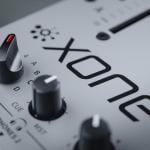
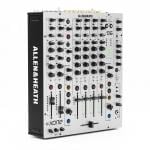
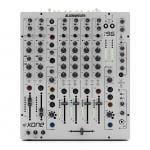

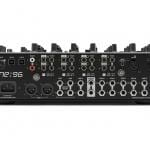
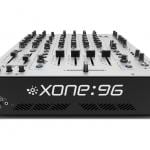

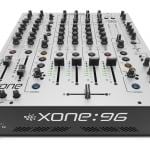
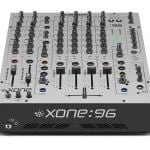
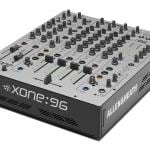
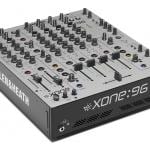
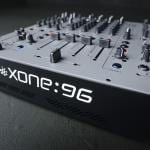
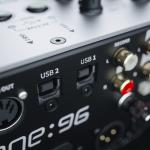
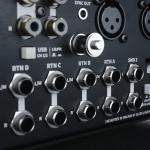
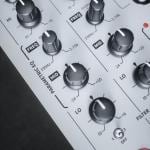
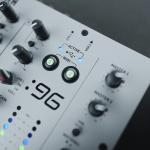

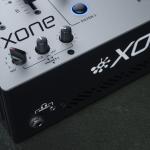

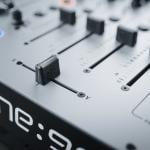
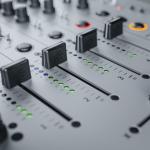








LINEAR channel faders.
Having it as a switch would be great. It’s probably the reason why some people won’t switch over to A&H.
Non-linear faders kept me from buying the 92 for sure!
I once was in contact with A&H when I had the beautiful Xone:42. I learned that linear faders are sounding logarithmic to human ears while logarithmic faders sound linear. Since I hated the linear faders (that sound logarithmic) I contacted their support team and was lead to an audio engineer who was actually involved in the design of the 42 – which was amazing support back then if you ask me :)
So he told me it was actually possible to change the faders behavior and they gave me the option to send the mixer in paying only the shipping costs to the UK (with the changes being free) or to send me instructions to change it myself (with the lost of the guaranty).
Unfortunately I decided to sell the 42 and buy a Denon DN-X1600 instead – a decision I still regret to this day as the Denon was crap that I sold just a year later.
Well, here’s your chance to redeem yourself! ;)
Fair enough.
Let’s hope they advertised “linear faders” meaning linear sounding faders.
Otherwise it would not make sense to mention it in their promo video if they did not change anything (vs the 92).
Took me quite a while to discover the new channel fader curve switch.
I guess that answers my question.
I didn’t look for it at first, but there is The Switch, just like on the PX5 and the DJMs. Glee!
erm, what’s that ”Audio sync out” output port for? Does this unit generate CV sync somehow?
you beat me to it! I was wondering the same thing. Where’s the PDF manual? LOL
I expected this to be priced about 2500€, what with a dual USB interface and such : well chuffed we all get to keep one kidney.
Now… is it class compliant? :>
OSX: according to the docs, yes. Of course, on Windows, you’re going to need a driver for the audio side of things. But, you know, you’ll also get slightly lower latency, so it’s an acceptable trade-off.
It turns out W10 has begun supporting USB Audio 2.0 a few releases ago so there is hope for driverless operation further down the line. I had a bit of a test and as of now, my A8DJ doesn’t work at all with it.
That’s not gonna happen. ASIO bypasses the OS layer by design, and WDM is crap. You can either have lowest possible latency or plug’n play, but not both. What’s the big deal with installing a driver anyway?
I mean really long term, for when the vendor doesn’t provide updates anymore and their stuff stops working.
Nothing lasts forever – but a mixer like this will likely outlast a run-of-the-mill audio interface.
WASAPI is supposed to be Microsoft’s answer to ASIO – low latency blah blah blah.
I’m missing:
– a mono switch on the master out(s).
– in/out switch for the master insert.
BTW Master Sounds fx unit seems to work only with their own mixers. Maybe A&H will come up with their version (audio sync out?).
Next wish: 2 ch version of PX5.
I would find it very surprising if it didn’t just use a similar FX loop to Xone stuff. The MasterSounds mixers were designed by the same person.
That’s right, but Master Sounds comment on their FB video says:
“…the
unique routing on MasterSounds FX means that it’s design is for use
with MasterSounds DJ mixers, both in current production and future
models. The FX section routes via our per channel send/return system,
whilst the filter and distortion section is routed on our master mix
insert.”
What is the need for the dipswitches that switch between line and phono input?
On the back? You use them to select which of the inputs gets routed to the soundcard.
Beast!
What is the purpose of a send/return loop on the master mix when you could always run the master output of any mixer through an effects processor?
How about proper master and booth control?
That makes sense.
If it’s not a proper insert then you won’t hear it in the cueing headphones for example. Also, you wouldn’t hear it in the booth like Ray mentions below.
Hopefully they aren’t outsourcing their so7nd card development otherwise this will be db4 nightmare all over again
Also someone should tell them that Mac OS X has a new version co I got in September. And they should start work on testing now
Is the DB4 really that bad? I started considering one after it got TSP certification :(
Allen & Heath, like most companies these days, don’t keep up with OS updates with the sound card drivers. Many people feel let down by the companies like A&H and others. I, feels apple is to blame. Apple claim there OSes and hardware is for pro users, but each updates kills simple things the pro users need like 3rd party drivers. That shouldn’t happen, if apple really cared about pro users and there attachments. Security update and adding Moji or other features shouldn’t effect the source for sound connections and if the new OS is causing issue with 3rd party attachment. Why can’t apple release a update to fix the OS issues. Instead of leaving it up to the 3rd parties companies to straighten things out.
Also, apple user like deejays and music producers, need to consider what’s more important. Keeping up with the latest OS or staying with the OS that support there gear. Or maybe, having a dedicated mac for your gear and a dedicated mac for everything thing else.
The problem isn’t the changes between OS versions, it’s the fact that there’s fundamental changes between the beta/RC and release. There’s also the issue of using 3rd party developers for drivers and software. When your hardware isn’t plug-n-play standard, you get issues with maintaining support a few years down the line.
In all honesty, I fully expect the mixer itself to continue working well past USB support. Just look at the 92.
That would be fine if this was sold as an analogue mixer, this was sold as a digital mixer. I agree the analogue stuff will work fine for years but if I wanted an analogue only mixer I would have bought something else. if an A&H engineer is reading this forum – don’t you take pride in the things you make? Or is it on to the next project? I get it – they are a business and making money is their priority. It’s a shame that the consumer gets the rear end of the stick.
You know the 92 is still available, right?
I was hoping this would be the last mixer it would ever need. Analogue connection and use – no issues, accept their LED VU meters SUCK….. when a KICK hits for example, there is a delay in the VU meter – seems to be a memory leak that causes the delay, if you power off/on the mixer it goes back to normal, but after awhile, goes out of sync so to speak. There are still some clicks and pops in the effects, and users were promised that updates would come on their forum – but they quickly closed the forum (it might be around on google cache so you can see the problems) – then there was issues with the sound card (mostly on mac) not working. This is due to the sound card not being built by them and needing a 3rd party to build/update the drivers for them. So basically it’s not in house control over it. I suspect they just want us to go away — but for $3000 I expect this thing to be flawless. There was also promises of new XLink hardware which hasn’t appeared since it was launched, the K1 was released which is just a K2 minus the sound card (probably used leftover parts). So I bought a K1 – it wouldn’t Link with the mixer and they couldn’t figure out why. Yet it’s still a current product – but they won’t update it anymore or fix any of the issues, I have it posted for sale, and will buy something else.
I am not a big fan of their sound card drivers and expect Polytec to be the same provider for the drivers. However, on a PC they worked fine (nowhere near efficient as my RME UFX drivers fo course). However, I will say this is an inherent problem with using any computer….as the OS gets updated, the drivers may require an update. As a Mixer the DB4 is great. I have had this for a number of years and don’t worry about the LED sync issue as it is hardly noticeable. As for clicks and pops in the effects…I use them heavily and never noticed this. The XLink feature seemed to stagnate. I was hoping for more features through the protocol though it does what it is supposed to do. I had two K2’s and worked flawlessly with them. I have one now and it works as expected but i have since ditched the laptop and use the one for Looping features only. The MIDI out using USB is a pain (in my setup / no laptop) because the mixer is not class compliant so it must be connected to a computer. Therefore I cannot sync my mixer to external hardware like the DJS-1000 or other my other synths. I found when I set the BPM of the mixer manually, the recorded loops fit better in the mix over longer periods of time. So, having the MIDI clock sync out is preferable. The MIDI Din out on the Xone:96 is interesting but since it doesn’t send clock…it has limited uses. That being said with a laptop I am pretty sure I can get creative with this aspect of connectivity. I am curious about the Xone:96 Sync out feature. I wonder what new hardware is in the works to make use of it.
I don’t suppose the fix for the VCF pop can be retro fitted to the Xone:92?
I hope there really is a fix. The article mentions ‘minimizing’ which is making me nervous.
Made in China, 2000$ the only improvement I see here is the profit margin for the company. I enjoy my Ecler made in Spain in combination with the Technics made in Japan. If you have decent records, thats all you need anyways.
You said “need”. Perhaps you’re unaware of how the technology industry works… ;)
I prefer wax cylinders. #realdjsusewaxcylinders
Or six channels of digital audio, four band EQ, Traktor, and Ableton Push. Whatever.
Apparently there are people who make balanced purchasing decisions based on their requirements, or “needs” as they are known. No really. Have you every heard of anything quite so ridiculous? Oh wait… I’m definitely asking the wrong guy. ;)
Hogwash I say… good day sir. I said good day.
You could always do with another webcam stand.
Well now….. This could very well wind up replacing my Kontrol Z2 due to a few reasons… Always did want a Xone:92, but for some reason never jumped onto it. This basically takes the couple of perks I really like about my Kontrol Z2 and makes it a nice, properly sized mixer between my turntables.
Oh, and so thankful they kept the four band EQ, even if it’s something that people either absolutely love or hate. So nice to see all the upgrades to the two mic channels – here’s hoping synths/drum machines/whatnot going through a DI won’t be any issue at all with this ^_^;;;;;
EDIT: Okay, never mind that last paragraph, thirty seconds looking at a larger full front pic of the mixer pretty much gives away a good amount of the answers I was looking at. Man that is one very, VERY tempting mixer!
I’d just like to find a mixer that allows for me to plug in my USB cable from my laptop and run audio from Native Instruments Studio without using a audio interface.